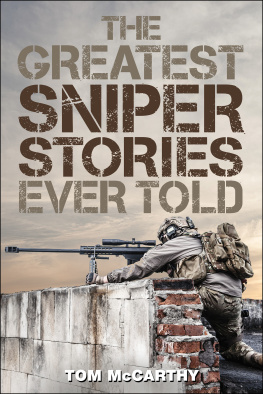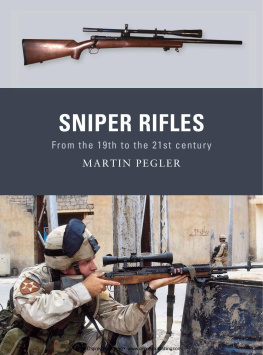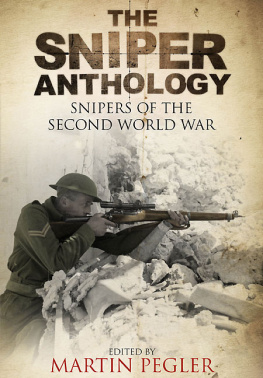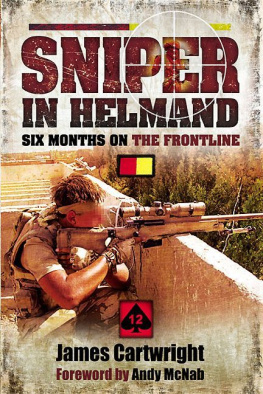This digital edition first published in 2012
Published by
Amber Books Ltd
Bradleys Close
7477 White Lion Street
London N1 9PF
United Kingdom
Website: www.amberbooks.co.uk
Appstore: itunes.com/apps/amberbooksltd
Facebook: www.facebook.com/amberbooks
Twitter: @amberbooks
Copyright 2012 Amber Books Ltd
ISBN: 978 190 827397 0
All rights reserved. With the exception of quoting brief passages for the purpose ofreview no part of this publication may be reproduced without prior writtenpermission from the publisher. The information in this book is true and completeto the best of our knowledge. All recommendations are made without any guaranteeon the part of the author or publisher, who also disclaim any liability incurred inconnection with the use of this data or specific details.
THE WARS OF EMPIRE
The keen eye and steady nerve of the accomplished marksman came to the fore during the latter half of the eighteenth century. The genesis of the modern sniper began in earnest during wars waged to gain empire and to achieve independence.
Perhaps the most significant rifle shot in military history is one which was never taken. On 7 September 1777, Major Patrick Ferguson of the Kings 70th Foot took aim at an American officer of obviously high rank, who was wearing a large cocked hat and sitting astride a bay horse. As the officer rode along the banks of Brandywine Creek in Pennsylvania, Ferguson contemplated pulling the trigger. He later wrote,
but it was not pleasant to shoot at the back of an unoffending individual, who was acquitting himself very coolly of his duty; so I let him alone.
Ferguson was well known in the British Army as a crack shot. He was also keenly aware of the potential value of soldiers who were skilled marksmen. The inventor of a breech-loading rifle which was far more accurate and even lighter in weight than the standard issue Brown Bess musket, Ferguson had been authorized to raise a force of 100 soldiers who would wear green uniforms, not the customary scarlet of the British Army. They would fight more like their very capable foe the backwoodsmen among the rebels, who employed stealth, cover and camouflage, along with the deadly accuracy of the Kentucky long rifle.
The American officer, who was reported to have been in the company of a French hussar, was none other than General George Washington, commander of the Continental Army and future president of the United States. Ferguson stated that he actually had Washington in his sights twice that day, and even commanded the general to halt. On my calling, he stopped; but after looking at me proceeded, continued the major. I again drew his attention, and made signs to him to stop, but he slowly continued on his way.
During the Battle of Brandywine four days later, Fergusons right elbow was shattered by a musket ball. After receiving treatment for his wound at a hospital on the battlefield, he wrote of his 7 September encounter. One of the surgeons who had been dressing the wounded rebel officers came in and told me that they had been informed that General Washington was all that day, with the light troops and only attended by a French officer in hussar dress, he himself dressed and mounted in every point as described. Even then, Ferguson maintained, I am not sorry that I did not know at the time who it was.
Although he never fully regained the use of his arm, Ferguson recovered to lead men in battle once again. On 7 October 1780, he was killed at the Battle of Kings Mountain, by a rifle shot reported to have been fired from 411m (450 yards) away. His quest to raise an elite fighting force died with him. Had the chivalrous Ferguson shot Washington out of his saddle, the American Revolution might well have had a different outcome, and for that matter the history of the world.
CRACK SHOTS
In Firearms In American History, Charles Winthrop Sawyer charts the impressive feats of the American Colonists in the Revolutionary War:
There is mention of a British soldier shot at [228m] 250 yards when only half his head was visible; of ten men, three of whom were officers, killed one day while reconnoitring; of a rifleman who, seeing some British on a scow at a distance of fully half a mile, found a good resting place on a hill and bombarded them until he potted the lot.
By the time of the Revolution, the British Army was already acquainted with the irregular combat tactics of backwoodsmen and Native Americans who had sided with their enemies. During the French and Indian War, an expedition led by General Edward Braddock against Fort Duquesne in western Pennsylvania met with disaster. On 13 July 1755, the British force of 2400 lost half its number killed and wounded when ambushed along the Monongahela River by a force of 900 French and Native American combatants. Braddock was killed in the engagement, and George Washington was also fortunate to escape with his life on this occasion.
ADVANCING TECHNOLOGY
The modern sniper may trace his lineage to the earliest days of the sighted firearm, but his evolution is rooted firmly in the era of wars for empire and conflict between Great Britain and her former colonies. Advancing technology was a key to the development of the sniper as well. The accuracy of the rifle was transforming the battlefield by the middle of the eighteenth century. This more accurate weapon would eventually take the place of the smoothbore musket.
The rifle itself came to prominence with game hunters in Central Europe and England in the seventeenth century, thence on to the New World. Its primary purpose, however, had remained as a hunting weapon. The use of the rifle in warfare had been discounted due to the expense of its manufacture and the time-consuming process required to load it. But, without regard for convention and the tactics of the European set-piece battle, American frontiersmen proved the rifle to indeed be a practical firearm which could be used to devastating effect in combat.
Born and raised in the wilderness and hunting game to survive, the colonial backwoodsman became as familiar with his small-calibre flintlock Kentucky rifle as he was with any other frontier necessity. On the day the American Revolution began, the colonial militia, known as minutemen for their ability to respond to an alarm at a moments notice, harassed the British with accurate sharpshooting from concealed positions. Brigadier General Hugh Percy led a reinforcing column which came to the aid of the hard-pressed Redcoats retiring to Boston from Lexington and Concord.
As it began now to grow pretty late and we had [24km] 15 miles to retire, and only 36 rounds, I ordered the grenadiers and light infantry to move first; and covered them with my brigade sending out very strong flanking parties which were absolutely very necessary, as there was not a stone wall, or house, though before in appearance evacuated, from whence the rebels did not fire upon us, Percy wrote later. As soon as they saw us begin to retire, they pressed very much upon our rear guard, which for that reason, I relieved every now and then. In this manner, we retired for [24km] 15 miles under incessant fire all round us, till we arrived at Charlestown, between 7 and 8 in the evening and having expended almost all our ammunition.
MORGANS RIFLEMEN
After the retreat from Concord, British forces were bottled up in Boston and continually under the watchful eyes of colonial marksmen. In his book Firearms In American History , Charles Winthrop Sawyer related, In the army around Boston the riflemen were employed as sharpshooters to pick off any British soldiers or officers who were incautious in exposing themselves. This they did to perfection.
In June 1775, the Continental Congress endorsed the recruitment of 10 companies of sharpshooting backwoodsmen, recognizing the important role these units might play during the war for American independence. These soldiers dressed primarily in fringed buckskin and often carried knives or tomahawks as secondary weapons. One of the most famous regiments of sharpshooters was known as Morgans Riflemen. Raised by Pennsylvania General Daniel Morgan, arguably the finest tactical field commander of the war and a cousin of pioneer legend Daniel Boone, the regiment, numbering 500, proved invaluable during the Saratoga campaign. One of their number, Tim Murphy, is remembered as the individual who felled Brigadier General Simon Fraser from a distance of 275 to 457m (300 to 500 yards) at the Battle of Bemis Heights on 7 October 1777.
Next page










